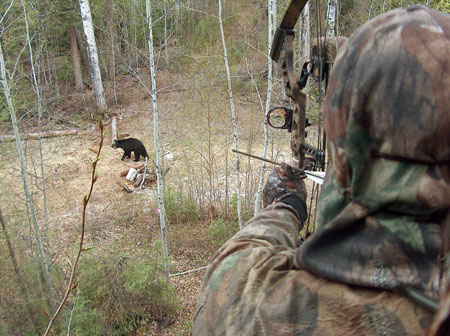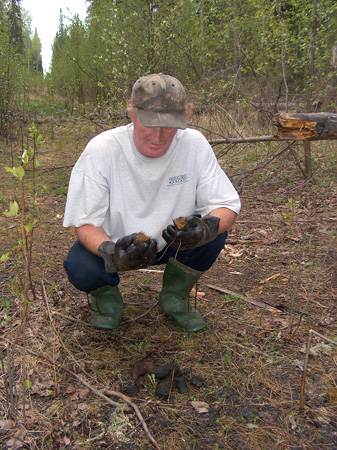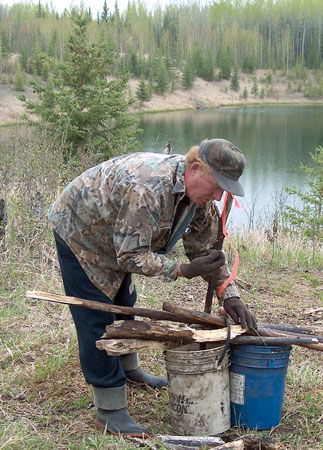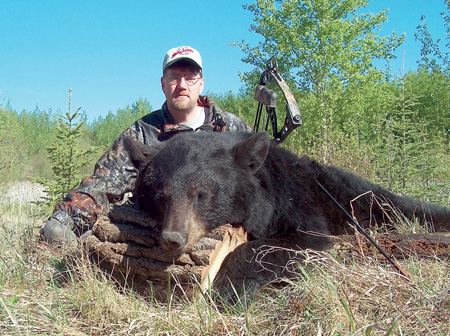 With one Pope & Young bear already down, I set my sights on a color-phased or Boone and Crocket qualifier. Because this bait site regularly produced a high percentage of color-phased bears, it was one of the rare sites Northern Wilderness Outfitters clients hunted regularly. All sign next to the recently trashed bait—large scat pile, enormous tracks, and blonde hairs—indicated that the bears, the kind I wanted, were still hitting this site hard. I decided to pin my hopes here.
With one Pope & Young bear already down, I set my sights on a color-phased or Boone and Crocket qualifier. Because this bait site regularly produced a high percentage of color-phased bears, it was one of the rare sites Northern Wilderness Outfitters clients hunted regularly. All sign next to the recently trashed bait—large scat pile, enormous tracks, and blonde hairs—indicated that the bears, the kind I wanted, were still hitting this site hard. I decided to pin my hopes here.
As my guide freshened the bait, I grabbed my ground blind and went to work. Under the branches of a large evergreen downwind of the bait and an established bear trail, I set up and blended my Matrix blind into the scenery. I then placed Ultimate Bear Lure at locations suitable for the shot. Slipping a layer of black over my Scent-Lok suit, I settled into the blind and switched to predator mode.
Before long, I caught movement of a distant bear. As it approached along the cut line, I could see that it only had use of three legs. Within 100 yards of the bait, the bear became ultra-cautious. Stopping, he tested the wind and began limping away. Struggling to make his way through the thick brush, his head shot up and turned to the scent. Filling his nostrils with the new and alluring odor, he altered his course back toward the bait. Hobbling several yards closer, the bear tested the wind again, lay down in exhaustion, and stared toward the empty ladder stand.
Witnessing the misery this creature was enduring, I knew that I’d have to take him. The combination of being injured and bait-shy slowed his progress over the final few yards.
Finally, he reached the opening. As he stood facing the scent, I came to full draw. One more labored step and an opening to his vitals appeared. Squeezing off the shot, the arrow sliced through his vitals. Within seconds, the death moan of surrender echoed through the woods.
Though the majestic creature fell well short of my goals, I used the same formula for success that I would have used to find and take Mr. Big.
Look For The Bear Hunting Honey Holes
 Black bears inhabit much of Alaska, Canada, and the western and north central United States, as well as in the East along the Appalachian Mountains from Maine to Florida. Within these regions, they run relatively large home ranges. A mature boar’s range typically averages over 100 square miles, and an adult sow’s averages around 10.
Black bears inhabit much of Alaska, Canada, and the western and north central United States, as well as in the East along the Appalachian Mountains from Maine to Florida. Within these regions, they run relatively large home ranges. A mature boar’s range typically averages over 100 square miles, and an adult sow’s averages around 10.
However, in any region that bears live, there are pockets that hold higher concentrations than others. These often-isolated pockets provide the best bear hunting. Having spent his entire life chasing bears, few know these honey holes better than Northern Wilderness Outfitters owner and top guide, Larry Jolliffe.
“Bears look for four main characteristics in their habitat,” Jolliffe says. “They want food, water, thick cover, and locations where they won’t be harassed. If bears find places that give them all of that better than they can find somewhere else, they gravitate to them.”
“Spring and fall offer different food sources that draw bears,” Jolliffe explains. “In spring, it’s fresh green growth, like grasses, clovers, and tender weeds. By fall, berries, nuts, and grain crops become hot choices. When trying to locate concentrations of bears, I look for spots that provide natural food. In spring, meadows and other grassy opens are the ticket. A wheat field or berry thicket can be the spot in fall.
“Then I look at the cover around it. If a swamp, a dense stand of young pines, a regrowth of saplings, or some other type of thick cover borders the food, I have the makings of a good spot. When water is close and the food is away from humans, I like it more. To prove that it’s as good as I think, I’ll scout it hard for bear sign or observe with my binoculars in the afternoon. It can be a lot of work to find these spots, but I’d rather find fewer great spots than have a bunch of OK areas.”
Create The Ultimate Bear Bait Site
 Once you locate a great spot, you can increase a bait’s draw. Where legal, lassoing rotting meat and hanging it high off the ground will create a long-distance call lure. An alternative is soaking rags in anise oil and hanging them as well.
Once you locate a great spot, you can increase a bait’s draw. Where legal, lassoing rotting meat and hanging it high off the ground will create a long-distance call lure. An alternative is soaking rags in anise oil and hanging them as well.
Another creative way to advertise a bait is by getting bears to create scent trails to the bait themselves. To do this, create a 4- or 5-inch-wide grease circle, out 2 or 3 feet from and surrounding the bait. Any bear hitting the site is likely to step in it. The bears then create a natural scent trail from the bait as they walk away on their grease-filled paws. Where bacon grease is illegal, I’ve found both Wildlife Research Center’s Ultimate Bear Lure and molasses to be effective alternatives.
Bait quality determines whether the bears become repeat customers. Where legal, fresh beaver and fish are hard to beat. When protected from rain, oats mixed with molasses and sugar, pastries, and popcorn are also good choices. A combination of two or more of these items, particularly when fresh meat is used, further increases drawing power.
Placing the bait where bears feel safe also helps. For example, placing a spring bait on a logging road, 50 yards in from the meadow, will increase a bear’s feeling of safety and increase the likelihood of daylight visits. Ideally, the bait site should offer several different stand locations to choose from depending on wind, and it should have enough thick cover to provide the illusion of safety while providing ample openings for shot opportunities.
Once several bears begin competing for the bait, you can further coax otherwise nocturnal bears into daylight visits. “We start most of our bait sites a month or more before they are hunted,” Jolliffe says. “In the beginning, we want there to be enough to last until we come back with more bait. We’re trying to draw as many bears as we can to a bait to create competition and more sightings for when our clients start hunting. As it gets closer to the time to hunt the bait site, we want the bait to be gone before dark. That forces the competing bears to come in during the hunter’s time in the stand or risk not getting any food.”
“Another way we condition them is by having our guides tend the baits as close to the same way and time each day. They use the same truck, ATV, or boat to get close to the bait and make the same sounds when baiting each time. That way when they drop hunters off, any bear that’s within earshot thinks it’s dinnertime. A lot of times our hunters see bears as soon as the guide leaves. When a bunch of bears are working a bait site, most of them can be pretty easy to trick into coming in early.”
Finally, strategically placing a flagged pole in the bait allows you to check the bait site from a distance. Doing so reduces trips directly to the site and, thus, the amount of human odor. With these simple techniques, Northern Wilderness Outfitters consistently provides 95 percent of its clients with opportunities at two bear. This speaks volumes about their effectiveness.
Monitor Your Bait Sites
Because baits can suddenly go cold, you need multiple active baits. This ensures that you have active baits to hunt, and it reduces overhunting on baits. The question then becomes which bait to hunt.
 You can determine this by creating track catchers. These help identify the most promising baits by providing data on the bear hitting the site. Rake debris from around the bait and along the bears’ approach trails. This creates a good surface for collecting tracks. Each time you refresh a bait site, look at the size of the tracks. Though it can be difficult to predict the route the bears will take to the bait, also raking their approach trails often offers the advantage of clearer tracks. Although large tracks don’t guarantee a large bear, front prints greater or equal to 5 inches wide by 4 inches long and back prints 5 inches by 7 inches often indicate a mature bear.
You can determine this by creating track catchers. These help identify the most promising baits by providing data on the bear hitting the site. Rake debris from around the bait and along the bears’ approach trails. This creates a good surface for collecting tracks. Each time you refresh a bait site, look at the size of the tracks. Though it can be difficult to predict the route the bears will take to the bait, also raking their approach trails often offers the advantage of clearer tracks. Although large tracks don’t guarantee a large bear, front prints greater or equal to 5 inches wide by 4 inches long and back prints 5 inches by 7 inches often indicate a mature bear.
The same holds true for scat. Large scat piles typically indicate a large bear. Close inspection of scat further reveals what natural foods a bear is utilizing. Another trick is to hang a scrap of bait 7 feet from the ground. Provided it’s hung far enough out on a branch so that a bear can’t climb for it, its disappearance is further proof of the presence of a big one. None of these criteria guarantees a monster bear, but when several of these indicators are at your bait site, it’s a pretty safe bet that Mr. Big is around.
Check the bait for hairs. Lighter ones indicate that a color-phase bear is using the site. Of course, trail cameras can also answer many of these questions, but one curious bear may ruin your camera.
For spring hunters, the presence of a lone sow is a good sign. As a sow nears readiness to breed, she kicks her yearlings out. A hot sow working a bait is a more effective draw than any bait can ever be. Considering all these factors makes selecting the right bait site much easier.
Sure, you can be a bear hunting success if you simply create a bait site along some thick cover in bear country. However, by targeting the honey holes, creating multiple baits, effectively advertising them, conditioning the bear for daylight visits, and sitting at the right bait site, you’ll stack the odds for consistent success in your favor.
Author’s Note: To book a bear, trophy whitetail, moose or elk hunt, contact Northern Wilderness Outfitters or call them toll-free: (888) 696-4868.






